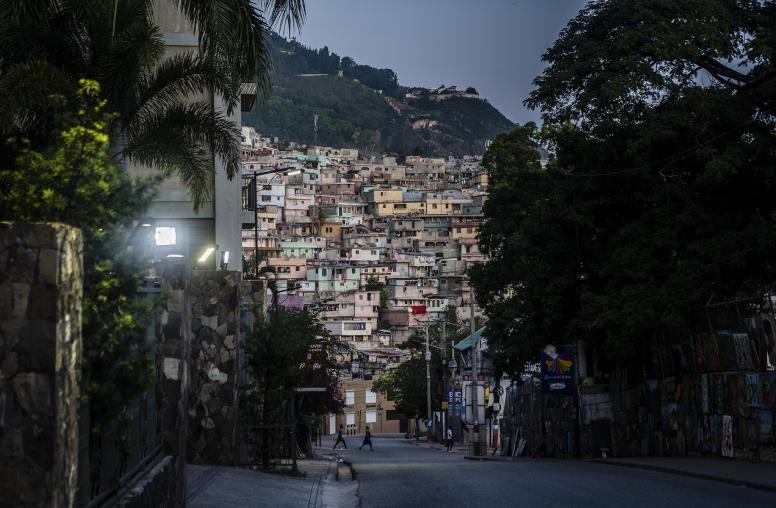Colombia Police Reform: The Critical Need to Include Rural Forces
Reshaping urban policing is essential, but the country’s peace deal hinges on places where the rule of law remains in question.
The Colombian government, seeking to reform its National Police in a time of security challenges and mass protests, has focused on big-city units that sit in the national spotlight. While the reform efforts are generally praiseworthy, the emphasis on urban areas creates the risk of losing sight of the country’s rural regions — places where guerrillas and other armed actors hold sway, and the fate of peace efforts will ultimately be determined. The resolve and capacity of rural police and courts to meet the needs of citizens in these zones will be critical to achieving meaningful and lasting peace.

Colombia had much to celebrate in November as it marked the fifth anniversary of the historic peace accords that ended combat between the government and the Revolutionary Armed Forces of Colombia (FARC), the country’s biggest rebel group. Some 14,000 insurgents had come in from the field and were now participating in the political process; small-scale economic development had slowly begun in the 170 municipalities most affected by the FARC; and a transitional justice system was starting to take hold.
But a single week in December made clear Colombia’s persistent security challenges — as two police officers died in a bombing at the Cucuta International airport on the Venezuelan border and the Bogota mayor’s office, with support from the U.N. High Commissioner for Human Rights, issued a report condemning the police killings of 11 citizens during demonstrations in September 2020. The incidents capped a year already marked by a significant uptick in violence, especially in rural municipalities, where social leaders, security officials and former combatants of the FARC have been killed in alarming numbers.
In Colombia, All Peace is Ultimately Rural
Colombia’s policymakers and leaders are grappling with a classic governance challenge: maintaining public safety while implementing meaningful security sector reforms.
The challenge is underscored most forcefully in “rural stabilization zones,” areas targeted for special attention in the peace process. They are among the most difficult places for policing in the hemisphere because of their remoteness, the persistent presence of armed groups, and their historic isolation from the central government and rule of law.
A key socioeconomic element of the 2016 peace agreement was the government’s pledge to begin closing the gap between the country’s center and periphery by providing services that would improve peoples’ lives. The state also made clear that it intended to bring the rule of law to these remote regions and replace the arbitrary security and justice arrangements that had prevailed under the FARC.
Traditionally, the state’s approach to citizen security has brought insufficient resources to bear in rural areas and, as a strategy, been geographically biased. The government was “focused mainly on large cities and municipal capitals, and absent in vast expanses of the national geography,” said Colombian security policy analysts Patricia Bulla and Sergio Guarin of the Colombian Foundation Ideas for Peace. Colombia’s leaders “placed special emphasis on the fight against illegal armed groups (national security), rather than responding to coexistence and security challenges (citizen security),” the two wrote in the International Journal of Security and Development in 2015.
Over the past three years, amid growing security problems and mass protests over police abuse, congressional and popular pressure has mounted to make the police address common crime more effectively, show greater respect for human rights and open broader dialogue with the communities where they operate.
That push began after the signing of the FARC peace accord, which largely left out security reform provisions. Colombian civil society and the country’s political class have engaged in spirited internal debates about security sector reform since then and floated a series of proposals.
The government under President Ivan Duque Marquez issued their Framework Policy on Citizen Security in 2019 that has tried to pull together the various proposals into a single strategy that would balance public safety — endangered by well-armed and violent elements — with protection of human rights and citizens’ concerns. The framework policy seeks to create a comprehensive plan for all ministries that impact citizen security — police, justice, military, social services, education and several others. But it is not clear that the new strategy goes far enough in addressing the imbalance between the more vocal demands of urban areas and the relative voicelessness of rural populations.
Three Narratives that Impede Progress on Rural Security
Three damaging narratives are largely responsible for Colombia’s persistent urban-rural gap in citizen security.
The first is political. Some prominent sectors of the Colombian political class assail the peace agreement of 2016 as the cause of the current escalation of rural violence and urban crime. The terms of the deal, they say, gave away too much to the surrendering insurgent movements under the threat of continued violence. They contend it was soft on punishment, lavish with future resources and provided an undeserved political perch for the former insurgents.
Unfortunately, this view extended broadly to the rural citizenry, who came to be viewed as guilty by association with the former guerrillas and treated with suspicion, their aspirations dismissed along with the demobilized armed groups. Some critics go so far as to blame the aggressiveness of recent urban protests over socioeconomic issues on the earlier example of “capitulation” to the demands of violent actors rather than allow that the discontent arises from citizens’ legitimate frustrations.
A second narrative views security problems in rural Colombia solely in criminal terms, pointing to the illegal armed groups that have organized illicit activities in the power vacuums left by the FARC’s demobilization. Under that analysis, the state security forces can narrowly focus on territorial control and the capture or neutralization of high-value targets within the criminal organizations and remain unresponsive to the needs of rural communities for public safety and the rule of law.
Third is an organizational narrative that remains linked to the logic of isolating and containing guerrilla forces, which for decades was the primary mission of the security services. Acting under this narrative, many security forces consider grassroots organizations susceptible to being co-opted by armed groups engaged in projecting their insurgent and criminal power. On the flip side, many local communities perceive state forces as hostile, untrustworthy institutions.
The last two narratives have in many cases been inadvertently promoted by the international community, the result of years spent bolstering militarized assets to recover territory and fight narcotics trafficking. More recently, many outsiders, including the United States, have shifted significantly to supporting real social and security-force reform in rural areas. But the inertia of the historic, war-time assistance to the Colombian military and police continues to provide incentives for uniformed and civilian decision-makers to approach rural security in a traditional — and now ineffective — way.
Going Forward
As the debate over police reform continues, politicians and policymakers would do well to see that rural areas in Colombia are put on par with urban ones and receive their fair share of resources and attention.
The challenge will be in the execution, ensuring any new models for rural policing are preventive rather than reactive. That is a critical issue in urban areas as well, but an acute one in the countryside, where timely response is so difficult. Forces must be deployed where they can react quickly and have the communications and mobility to support proactive engagement with citizens rather than simply after-the-fact responsiveness to crime and violence. And they will need to be trained to minimize the “collateral damage” from highly disruptive interventions such as the capture or neutralization of drug trafficking organizations and other guerrilla leaders that often lead to violent encounters. For all of this they will need sufficient resources and high-quality personnel who are assigned close to communities for lengthy periods of time.
Execution will also depend on involvement by other elements of the state. The government recognizes that to be effective, a rural citizen security strategy must include not only the police and judiciary but also the army, the Ombudsmen’s Office for Human Rights, local governments and other agencies that provide government services. Rather than government agencies parachuting in from the capital and departing once engagement is completed, which has been the historic norm, there should be a local coordination mechanism where they can all synergize their efforts.
Another issue, under debate now in the Colombian Congress, relates to career incentives for law enforcement agents to serve in hard-hit rural regions. Instead of appointing officers to complex rural communities as a disciplinary measure, the upward path in a police career should encourage the most capable and willing officers to serve in the areas where they are most needed.
Finally, because the conditions of rural areas diverge so sharply, authorities would also do well to invigorate dialogue at the local level between citizens and justice and security providers. USIP’s Citizen Security Dialogues project is one of several efforts aimed at reestablishing trust between communities and government institutions.
With the current wave of popular support and congressional attention, the Colombian government has an unprecedented opportunity to strengthen the police service and constructively build a citizen security strategy that responds to the interests and needs of all of Colombia’s people. Focusing equitably on the urban and rural sectors will not only help reduce crime and violence but will shore up complex and challenging efforts to bolster the peace.
Nicolas Devia-Valbuena is a project assistant for the Latin America team at USIP.
Carlos Hoyos is a project officer for USIP’s Citizen Security Dialogue Activity in Colombia.


